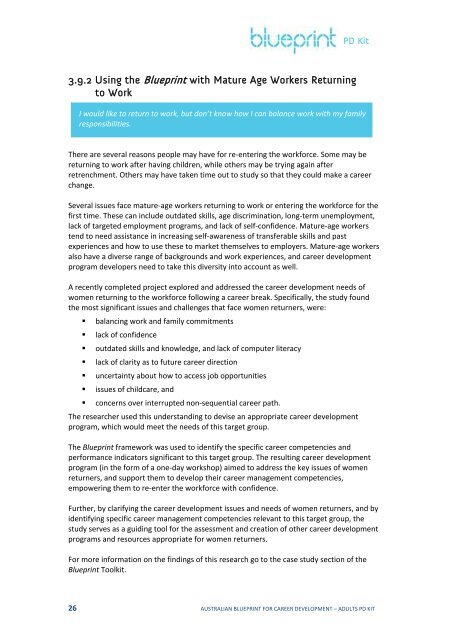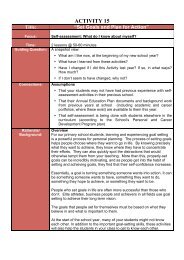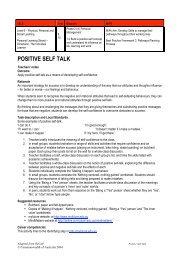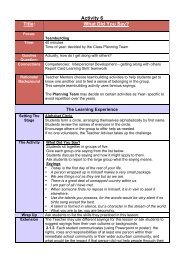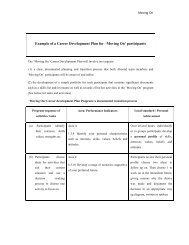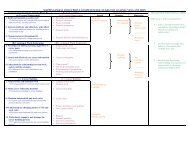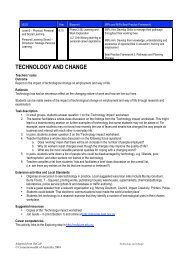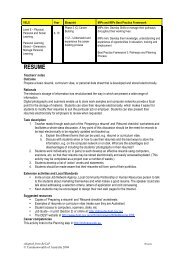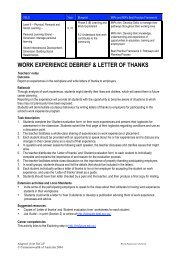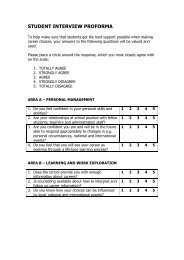Re-write of case studies - Blueprint - Australian Blueprint for Career ...
Re-write of case studies - Blueprint - Australian Blueprint for Career ...
Re-write of case studies - Blueprint - Australian Blueprint for Career ...
Create successful ePaper yourself
Turn your PDF publications into a flip-book with our unique Google optimized e-Paper software.
PD Kit<br />
3.9.2 Using the <strong>Blueprint</strong> with Mature Age Workers <strong>Re</strong>turning<br />
to Work<br />
I would like to return to work, but don’t know how I can balance work with my family<br />
responsibilities.<br />
There are several reasons people may have <strong>for</strong> re-entering the work<strong>for</strong>ce. Some may be<br />
returning to work after having children, while others may be trying again after<br />
retrenchment. Others may have taken time out to study so that they could make a career<br />
change.<br />
Several issues face mature-age workers returning to work or entering the work<strong>for</strong>ce <strong>for</strong> the<br />
first time. These can include outdated skills, age discrimination, long-term unemployment,<br />
lack <strong>of</strong> targeted employment programs, and lack <strong>of</strong> self-confidence. Mature-age workers<br />
tend to need assistance in increasing self-awareness <strong>of</strong> transferable skills and past<br />
experiences and how to use these to market themselves to employers. Mature-age workers<br />
also have a diverse range <strong>of</strong> backgrounds and work experiences, and career development<br />
program developers need to take this diversity into account as well.<br />
A recently completed project explored and addressed the career development needs <strong>of</strong><br />
women returning to the work<strong>for</strong>ce following a career break. Specifically, the study found<br />
the most significant issues and challenges that face women returners, were:<br />
• balancing work and family commitments<br />
• lack <strong>of</strong> confidence<br />
• outdated skills and knowledge, and lack <strong>of</strong> computer literacy<br />
• lack <strong>of</strong> clarity as to future career direction<br />
• uncertainty about how to access job opportunities<br />
• issues <strong>of</strong> childcare, and<br />
• concerns over interrupted non-sequential career path.<br />
The researcher used this understanding to devise an appropriate career development<br />
program, which would meet the needs <strong>of</strong> this target group.<br />
The <strong>Blueprint</strong> framework was used to identify the specific career competencies and<br />
per<strong>for</strong>mance indicators significant to this target group. The resulting career development<br />
program (in the <strong>for</strong>m <strong>of</strong> a one-day workshop) aimed to address the key issues <strong>of</strong> women<br />
returners, and support them to develop their career management competencies,<br />
empowering them to re-enter the work<strong>for</strong>ce with confidence.<br />
Further, by clarifying the career development issues and needs <strong>of</strong> women returners, and by<br />
identifying specific career management competencies relevant to this target group, the<br />
study serves as a guiding tool <strong>for</strong> the assessment and creation <strong>of</strong> other career development<br />
programs and resources appropriate <strong>for</strong> women returners.<br />
For more in<strong>for</strong>mation on the findings <strong>of</strong> this research go to the <strong>case</strong> study section <strong>of</strong> the<br />
<strong>Blueprint</strong> Toolkit.<br />
26 AUSTRALIAN BLUEPRINT FOR CAREER DEVELOPMENT – ADULTS PD KIT


